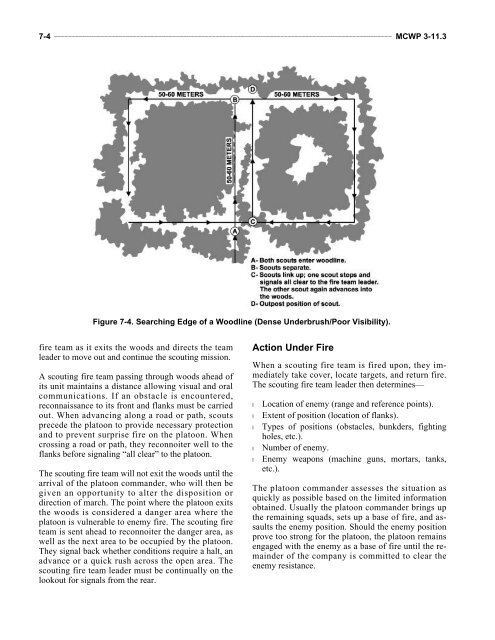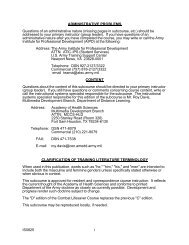MCWP-3-11.3-Scouting-and-Patrolling
MCWP-3-11.3-Scouting-and-Patrolling
MCWP-3-11.3-Scouting-and-Patrolling
Create successful ePaper yourself
Turn your PDF publications into a flip-book with our unique Google optimized e-Paper software.
7-4 ______________________________________________________________________________________________ <strong>MCWP</strong> 3-<strong>11.3</strong>Figure 7-4. Searching Edge of a Woodline (Dense Underbrush/Poor Visibility).fire team as it exits the woods <strong>and</strong> directs the teamleader to move out <strong>and</strong> continue the scouting mission.A scouting fire team passing through woods ahead ofits unit maintains a distance allowing visual <strong>and</strong> oralcommunications. If an obstacle is encountered,reconnaissance to its front <strong>and</strong> flanks must be carriedout. When advancing along a road or path, scoutsprecede the platoon to provide necessary protection<strong>and</strong> to prevent surprise fire on the platoon. Whencrossing a road or path, they reconnoiter well to theflanks before signaling “all clear” to the platoon.The scouting fire team will not exit the woods until thearrival of the platoon comm<strong>and</strong>er, who will then begiven an opportunity to alter the disposition ordirection of march. The point where the platoon exitsthe woods is considered a danger area where theplatoon is vulnerable to enemy fire. The scouting fireteam is sent ahead to reconnoiter the danger area, aswell as the next area to be occupied by the platoon.They signal back whether conditions require a halt, anadvance or a quick rush across the open area. Thescouting fire team leader must be continually on thelookout for signals from the rear.Action Under FireWhen a scouting fire team is fired upon, they immediatelytake cover, locate targets, <strong>and</strong> return fire.The scouting fire team leader then determines—l Location of enemy (range <strong>and</strong> reference points).l Extent of position (location of flanks).l Types of positions (obstacles, bunkders, fightingholes, etc.).l Number of enemy.l Enemy weapons (machine guns, mortars, tanks,etc.).The platoon comm<strong>and</strong>er assesses the situation asquickly as possible based on the limited informationobtained. Usually the platoon comm<strong>and</strong>er brings upthe remaining squads, sets up a base of fire, <strong>and</strong> assaultsthe enemy position. Should the enemy positionprove too strong for the platoon, the platoon remainsengaged with the enemy as a base of fire until the remainderof the company is committed to clear theenemy resistance.



